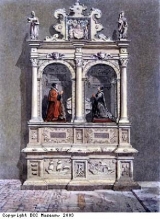Bristol and the East African slave trade
Bristol merchants had long-standing links with the East India Company (the London-based trading company that traded with the East Indies region). According to the historian C M MacInnes, ‘men from Bristol took an active and leading part [in the establishment of the East India Company] and in the course of the next three hundred years some of the most illustrious names in Anglo-Indian history came from that city.’ Bristol merchants brought Indian textiles from the East India Company to trade with West Africa. Given the importance of Indian textiles to the African trade, it is not surprising to see Bristol merchant families involved in both the East Indian trade and the transatlantic slave trade .
Take the Aldworth family, for example. The Aldworths of Bristol seem to have had early connections with the East India Company. In 1611 Thomas Aldworth became the chief merchant on board the ship the Hosiander, which sailed to the East Indies that year. By 1612 Aldworth was in charge of a trading station on the west coast of India, which became one of the most important trading stations in the East India Company’ empire. Thomas Aldworth also owned the ship the Gabriel of Bristol. The Gabriel is recorded as making a voyage to buy animal skins, ivory and salt from the west coast of Africa early in the 17th century.
By 1618, Robert Aldworth, Thomas Aldworth’s relative, was involved in the first sugar processing business in Bristol. Sugar was processed in ‘sugar houses’ in Bristol and sold. Aldworth’s sugar house was probably refining slave-produced sugar from Spanish and Portuguese plantations in Madeira, Brazil and the Azores. Later, the sugar came from the Caribbean plantations. Robert Aldworth became Bristol’s wealthiest sugar merchant. He was Mayor of Bistol in 1609. Robert Aldworth was obviously proud of his trade in sugar. His magnificent tomb, which is pictured here, in St Peters Church in the centre of Bristol had sugar loaves carved on it. Both Thomas and Robert Aldworth were members of the Society of Merchant Venturers, a group dating back to the 16th century to promote and protect Bristol merchants and trade. This included involvement in the transatlantic slave trade. In 1672 another Thomas Aldworth was a member of the new Royal African Company. This was a London-based company which was granted a monopoly of English trade with Africa. At the same time, a Thomas Aldworth was listed as a landowner in St Andrews’ parish in Jamaica in the Caribbean.
John Duckinfield, or Duckenfield was another merchant from Bristol who was linked to the trade with the East Indies as well as Africa. By 1701 he had become a wealthy merchant and was also an investor in the slave trade. In most of the years between 1712 and 1735, Duckinfield sent out at least one of his six ships on slaving voyages. Most of them followed the route from Bristol to Africa and thence from Africa to the Caribbean and back to Bristol. But on at least two occasions he traded in slaves from the island of Madagascar off the east coast of Africa. Trade with that area was at that time under the exclusive control of the East India Company. It was illegal for private traders such as Duckinfield to take part unless they had a temporary licence from the East India Company. In 1717 we know that Duckinfield bought such a licence. He loaded some 540 slaves on board his ship the Prince Eugene at Madagascar. Most were young boys and girls, and over half of them died on the voyage east. After that Duckinfield does not seem to have got another licence from the East India Company and later went on a similar slaving voyage, trading illegally without a licence. He was eventually found out, and had his ship’s cargo impounded.



